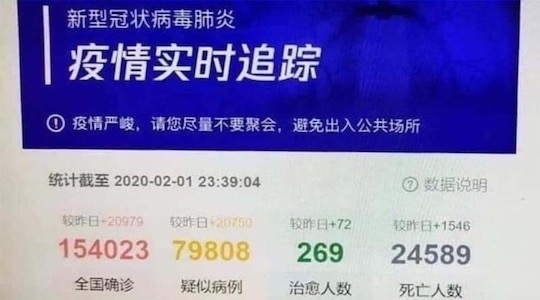Markets are still bobbing along at all-time highs.
Yet I can’t help but wonder why.
According to Jim, the coronavirus is not only worse than we know…the economic impact is still to be felt.
Shares in Apple Inc [NASDAQ:AAPL] for example, are rather lofty.
Yet three days ago CEOs at Apple announced not only were 42 stores in China shut, but the supply of their smartphones were affected.
Those two factors will hurt the company’s earnings later on.
So investors still rushing into Apple is rather baffling.
Is this a bit of mania playing out…before the coronavirus triggers some sort of market panic?
The thing with a market panic is, most people think they are smart enough to get out ahead of the crowd. That they’ll have the foresight to avoid the trouble every other investor will be left with.
In practice it doesn’t work that way. Investors can be like herds, and once they realise the news is bad, they all start hitting the sell button at the same time.
So today, consider this a timely warning.
Sure you may have beaten the crowd so far.
But what if the panic is different this time? What if when markets tank, there is no getting your cash back from your broker? What if this time around, you find yourself locked in a banking system you can’t get out of?
Not only can it happen, but it’s likely to happen, says Jim.
A ‘monetary reset’ is looming, and you need to see what it means for your investments.
Now, it’s over to Jim.
|
Until next time, |
|
Shae Russell, |
[conversion type=”in_post”]
When Bad News Becomes
Worse News
 |
How bad is the coronavirus pandemic in China? It’s worse than the Chinese government knows and worse than the world believes.
Here are the official statistics on the coronavirus (technically COVID-19) as of 18 February 2020: There are 74,351 confirmed infections worldwide, with 72,439 (98% of the total) in China alone.
Of those cases, 59,989 (82.5% of the Chinese total) are in the single province of Hubei, mostly centred in the city of Wuhan, with 11 million residents.
Of the 74,351 worldwide cases, there have been 1,870 deaths and 12,994 recoveries; that’s a mortality rate of roughly 2.5%.
If a 2.5% mortality rate sounds low, it’s not.
That’s roughly comparable to the Spanish flu pandemic of 1919–20 that killed 50 million people by some estimates.
While the disease has been predominately centred in China, and Wuhan in particular, there have been significant outbreaks in Singapore (58 cases), Hong Kong (56 cases), Thailand (33 cases), and Japan (29 cases including one fatality).
Approximately 218 cases have been identified among those trapped on cruise ships where all passengers are under quarantine. 15 cases have been identified in the United States.
These statistics barely scratch the surface of what is happening with coronavirus in China.
There is good reason to believe that the actual incidence of the virus may be 5–10 times the official numbers…
10 times higher than official numbers?
Tencent (a popular internet search and social media platform in China) reported on 1 February 2020, that actual infections were 154,000 and deaths from the disease were 24,589.
|
|
|
A screenshot of the Tencent release. Source: Taiwan News |
The infection figure was approximately 10 times what the official figure was on the same date. The death toll was more than 300 times the official figure.
Applying this death toll to total infections gives a fatality rate of 16%, which is over seven times the official fatality rate.
There is no reason for a high-profile platform such as Tencent either to fabricate data or incite panic. It is reasonable to conclude that these figures are close to actual data.
The Tencent posting was suppressed by the Chinese government within minutes of what may have been an accidental release of accurate data.
The preeminent UK medical journal The Lancet also published an article on 31 January 2020, using hard data (city populations, incidence of travel, estimated transmissibility, etc.) and a reliable SEIR model (susceptible, exposed, infected, resistant).
That article estimated total infections of 75,815 in Wuhan as of 25 January. That figure is 17 times the official figure of 4,400 available on 27 January.
The multiple of the estimate by The Lancet to the official figure is roughly in line with the multiple of the Tencent release to official data five days later.
Using either The Lancet or Tencent as a baseline suggests that the official infection and death rates are grossly understated.
Anecdotal evidence is consistent with the view that official data is materially understated.
Many bodies have been picked up off the streets and sent for cremation without blood samples or autopsies.
It is highly likely that these victims died from coronavirus but are not included in official counts because no tests were performed. Authorities are running out of body bags and refrigerated trucks, so bodies are simply being wrapped in plastic sheets and hauled away in ordinary vans.
A shortage of face masks, latex gloves, and testing kits has also emerged.
This means that doctors and medical personnel are highly susceptible to infection. It also means that patients who complain of fever and difficulty breathing are sent away because officials have no way to test them for coronavirus. These developments simultaneously inflate the number of infected and deflate the official count.
Still no good news on the Coronavirus
The story gets worse.
Wuhan, the city that is ground zero for coronavirus infections, is also the location of the sole bioweapons laboratory for the Chinese military and Chinese Communist Party.
One of the scientists at the laboratory is Zhengli Shi, a virologist.
Shi formerly worked at a laboratory at the University of North Carolina, where he engineered a hypervirulent bat-based coronavirus that bears a striking resemblance to the COVID-19 coronavirus, including gene sequences not found in nature.
These linkages at least suggest that the outbreak of the coronavirus in Wuhan may be linked to an accidental release of the virus from the biological weapons laboratory located there.
If this thesis is correct, the coronavirus may be difficult to contain with vaccines or drug therapies since it would have been engineered to be highly resistant to such treatments.
What impact will the coronavirus pandemic have on the Chinese economy and global supply chains, especially in the technology sector?
Right now my analysis is telling me that the impact of coronavirus on the Chinese economy is orders of magnitude greater than most analysts estimate.
In fact, the Chinese economy, second largest in the world, may be grinding to a halt.
The following excerpt from an article by Ambrose Evans-Pritchard in The Telegraph on 12 February 2020, tells the tale:
‘Property sales in 30 big cities released every day… have collapsed to zero and have yet to show a flicker of life.
‘Property is a slow-burn issue compared to ruptured manufacturing supply chains, but by March it will start to bite for developers with dollar debts on Hong Kong’s funding market. Companies deemed “stressed” (borrowing costs above 15%) have to repay $2.1 billion of offshore dollar notes next month. Standard & Poor’s says they rely on a constant flow of sales to cover past debts.
‘Some 25 provinces and municipalities were supposed to go back to work this week but this clashed head on with virus control measures. Companies may not reopen plants unless they can track the exact movements and medical data of each worker and comply with a 14-day quarantine period where necessary (we now learn the incubation may in fact be 24 days). Officials dare not be lenient after Xi Jinping’s latest tirade.
‘The Guangzhou authorities have ordered plants to remain closed until early March in large parts of the city with warnings of ferocious penalties. Apple supplier Foxconn has yet to restart its core iPhone plants in Zhengzhou and Shenzhen. Just 10% of its workers have turned up. Caixin reports that Foxconn may wait until March before restarting.
‘Meanwhile the near complete shutdown of Shanghai’s manufacturing hub in Songjiang belied early claims that 70% of plants were going back to work.’
This article contains valuable vignettes of what is happening in China, but they barely scratch the surface…
Supply chain disruptions will impact the global economy
An even bigger story is the extent to which the disruption in China from coronavirus is not only slowing the Chinese economy, but is also disrupting global supply chains and slowing output around the world.
Production shutdowns in China are reducing exports of high-tech inputs from South Korea, Japan, and Germany.
Likewise, the extreme reductions in exports from China (due to plant closures) are hurting sales by European and US distributors and retail outlets.
Independent of production and sales bottlenecks, there are massive transportation bottlenecks as vessels and crews are quarantined or refuse to enter Chinese ports at all.
The tech sector may be the hardest hit of all. In addition to coronavirus disruption, the US Department of Justice last week indicted China’s largest telecommunications device and network provider, Huawei, on racketeering charges.
The Pentagon also reversed a prior determination and agreed that the Commerce Department can put Huawei on an export control list, which prohibits sales of processors and other high-tech components to Huawei by US firms.
These measures are certain to invite retaliation by China against US firms in the tech supply chain.
|
All the best, |
 |
|
Jim Rickards, PS: Discover the easiest way to start investing in gold in Australia. In fact, it’s as easy as buying a book on Amazon! Click here to read the FREE report. |


